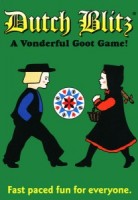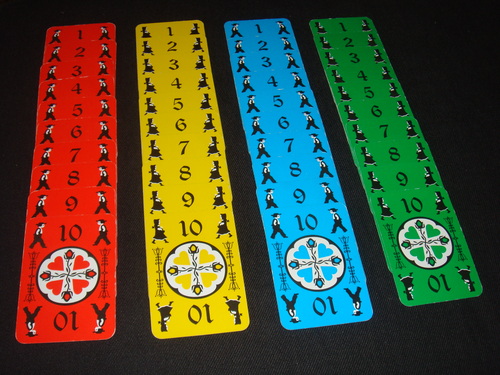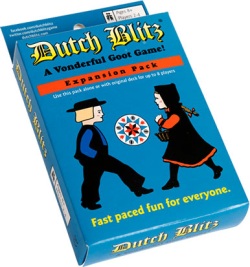
Dutch Blitz
A Vonderful Goot Game!
Dutch Blitz is such vonderful goot fun
For young folks — and old ones too.
Vhy you should see the vones who plays:
They gets in such a stew.
Easy to learn — exciting to play
For two or three or four.
And this for sure is vone such game,
That ain't gonna be no bore.
So now, sit down with your friend or kin,
And try this game to play.
Chust bet that vhen you get started vonc't,
You'll play for most the day!
What is Dutch Blitz?
Dutch Blitz is a highly interactive, highly energetic, family-friendly card game that will test your skills, smarts and speed.
It’s the kind of game that makes your brain work really hard. But because you’re having so much fun, you won’t even notice. Perfect for parties and family game nights, Dutch Blitz has been a favorite of card players for decades — and it’s more popular today than ever.

How did Dutch Blitz begin?
Dutch Blitz was the brainchild of Werner Ernst George Muller, a German immigrant and optometrist who thought the game might help his children more easily learn about colors and numbers.
We can’t tell you whether or not Dutch Blitz accomplished that goal. All we know is that, somewhere along the line, Muller’s game captured the imaginations of gamers throughout Eastern and Central Pennsylvania.
The game has since spread far and wide, and today, Dutch Blitz fans can be found in every corner of the world and can be purchased at more than 200 different locations in 11 different countries.

BGdot Note: The publisher released a blue-box Expansion Pack in 2012, which is designed to be played as a standalone game, or combined with the original for up to 8 players. The Expansion Pack is identical to the base Dutch Blitz game, saving only for the combination of colors and symbols distinguishing the cards. It will not be listed as a separate game.
User Reviews (1)
Add a Review for "Dutch Blitz"
You must be logged in to add a review.


That’s the most basic description I can give Dutch Blitz: group Solitaire, on speed. I am half-Dutch by blood, and if you’ve had the opportunity to meet any Dutch people, it becomes pretty clear pretty quickly that we’re proud of our heritage. Dutch Blitz — or Nertz, as it’s also called among us — is a chance to prove who’s the quickest, and most circumspect, Dutchman among us.
Set Up
The base set includes four decks of cards, identified by four symbols — plough, pail, pump, carriage — on their back, each with four color-coded “suits” — orange, yellow, blue, green — of values 1-10 on their face. Each player takes one deck, shuffles, and lays three cards — called the “Post” piles — face up in front of them; ten cards (face down, with the top card face up) are counted into a “Blitz” pile to the right of the “Post” piles. The remaining cards are held in the players’ hands, face down.
Play
When everyone is ready, players turn cards from their hands 3 at a time over onto the table in front of them onto a “Wood” pile. The top card on the “Wood” pile and the top card on the “Blitz” pile can be sorted onto the players’ own “Post” piles in descending order by number, alternating boy-girl, boy-girl (Orange and blue cards have pictures of Pennsylvania Dutch boys; green and yellow cards have pictures of Pennsylvania Dutch girls), or onto the common, color-specific “Dutch” piles in the center of the table in ascending order. If it sounds familiar, it’s because the game plays like Solitaire. The game is over when the first player finishes sorting their “Blitz” pile of ten cards onto the other piles. But the winner is the player who sorted the most cards into the center “Dutch” piles; the first player to finish gets a bonus 10 points, and the other player(s) subtract their remaining “Blitz” cards from their points.
Overall Impression
Because it’s essentially Solitaire, you can play Dutch Blitz with a standard deck of cards for each player (each deck must be discernibly different enough to keep track of points at the end of the game) and removing the face cards (Jokers, Jacks, Queens, and Kings). In fact, this is how I learned the game, so it was actually a bit difficult to get used to noticing the difference between the Dutch boy and the Dutch girl (the images are too small and too similar at a quick glance), after being used to alternating red-black, red-black. But the great thing about buying this edition of the game is that the decks are prepared, color-coded, and uniform in appearance.
Games are best played with 3-4 players. 2 works okay, though it is easier to get stuck without playable options available. 5-6 works (with the expansion), as long as the table gives everyone room to play in front of them and reach across to all the “Dutch” piles.
Games go fast. It becomes challenging to see all the options available and all the cards to be sorted and what everyone else could be playing, and then play your cards to help yourself and not others. I don’t do well with the multi-tasking required, and my wife usually beats me. And there is definitely a dexterity mechanic to this game: hands are forfeit when two people need to get their cards on the same “Dutch” pile.
That being said, there is a great deal of luck involved, in how the cards are shuffled: there can be lulls in play where no one has any options for a few hands; some games go fast because one person’s “Blitz” pile was perfectly arranged; and some games take quite a while because all the ones are buried. Still, there can be strategy used: someone who knows how to play can watch the table to get their cards out before someone less aware, and still stall the win until they get more of their cards into the middle.
Recommendations
I would recommend this to pretty much any gamer:
Family – Yes, absolutely. The simple combination of colors and numbers makes it easy for most children older than 7 or 8. Of course, if your family boasts more than 4, you’ll need the expansion.
Strategy – Yes, maybe. Like I said, there’s a fair amount of luck in the draw of the card, but there’s also plenty of opportunities to strategically play from the draw onward.
Social – Not really. There is very little personal interaction between players because the call for concentration is so high during game play.
Avid – Yes, absolutely. Games are easy to learn, easy to teach, and play pretty quickly, and that means more time for more rounds, or other games.
Casual – Yes, absolutely. Quick, simple, colorful, and gripping.
Power – Yes, maybe. There is a small feeling of conquest as you clear your “Blitz” pile faster than others, and hear their moans of frustration and sighs of despair that can be quite satisfying.